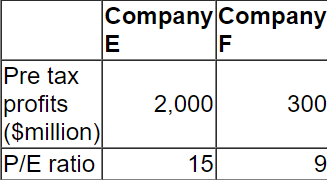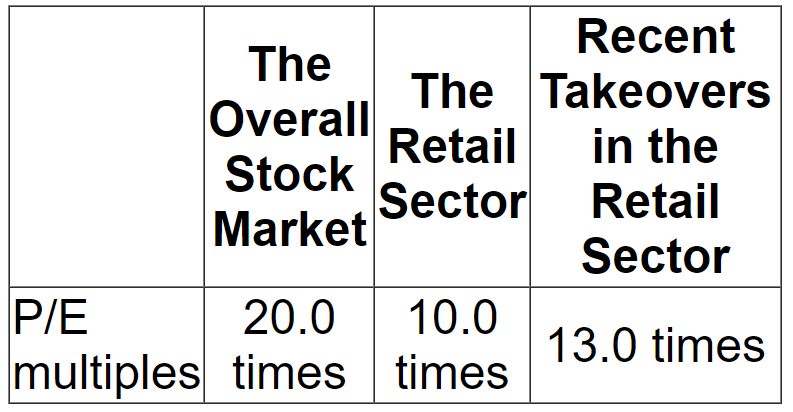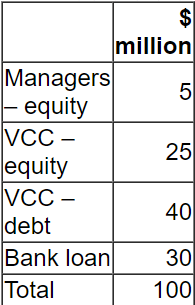CIMA F3 - Financial Strategy
Company WWW is identical in all operating and risk characteristics to Company ZZZ. but their capital structures differ. Company WWW and Company ZZZ both pay corporate income tax at 20%
Company WWW has a gearing ratio (debt: equity) of 1:3 Its pre-tax cost of debt is 6%.
Company ZZZ Is all-equity financed. Its cost of equity is 15%
What is the cost of equity tor Company WWW?
Company E is a listed company. Its directors are valuing a smaller listed company, Company F, as a possible acquisition.
The two companies operate in the same markets and have the same business risk.
Relevant data on the two companies is as follows:
  
Both companies are wholly equity financed and both pay corporate tax at 30%.
The directors of Company E believe they can "bootstrap" Company F's earnings to improve performance.
Calculate the maximum price that Company E should offer to Company F's shareholders to acquire the company.
Â
Give your answer to the nearest $million.
Â
A company is planning a new share issue.
The funds raised will be used to repay debt on which it is currently paying a high interest rate.
Operating profit and dividends are expected to remain unchanged in the near future.
If the share issue is implemented, which THREE of the following are most likely to increase?
On 1 January:
• Company ABB has a value of $55 million
• Company BBA has a value of $25 million
• Both companies are wholly equity financed
Company ABB plans to take over Company BBA by means of a share exchange Following the acquisition the post-tax cashflow of Company ABB for the foreseeable future is estimated to be $10 million each year The post-acquisition cost of equity is expected to be 10%
What is the best estimate of the value of the synergy that would arise from the acquisition?
A company in country T is considering either exporting its product directly to customers in country P or establishing a manufacturing subsidiary in country P.
The corporate tax rate in country T is 20% and 25% tax depreciation allowances are available
Which TIIRCC of the following would be considered advantages of establishing a subsidiary in country T?
A company needs to raise $20 million to finance a project.
It has decided on a rights issue at a discount of 20% to its current market share price.
There are currently 20 million shares in issue with a nominal value of $1 and a market price of $5 per share.
 
Calculate the terms of the rights issue.
A company intends to sell one of its business units, Company R by a management buyout (MBO).
A selling price of $100 million has been agreed.
The managers are discussing with a bank and a venture capital company (VCC)Â the following financing proposal:
  
The VCC requires a minimum return on its equity investment in the MBO of 30% a year on a compound basis over 5 years.
Â
What is the minimum TOTAL equity value of Company R in 5 years time in order to meet the VCC's required return?
Â
Give your answer to one decimal place.
Â
$ Â ? millionÂ
A company is considering hedging the interest rate risk on a 3-year floating rate borrowing linked to the 12-month risk-free rate.
If the 12-month risk-free rate for the next three years is 2%, 3% and 4%, which of the following alternatives would result in the lowest average finance cost for the company over the three years?
A wholly equity financed company has the following objectives:
1. Increase in profit before interest and tax by at least 10% per year.
2. Maintain a dividend payout ratio of 40% of earnings per year.
Â
Relevant data:
   • There are 2 million shares in issue.
   • Profit before interest and tax in the last financial year was $4 million.
   • The corporate income tax rate is 20%.
At the beginning of the current financial year, the company raised long term debt of $2 million at 5% interest each year.Â
Â
Calculate the dividend per share that will be announced this year assuming the company achieves its objective of increasing profit before interest and tax by 10%.
A company is owned by its five directors who want to sell the business. Â
Current profit after tax is $750,000. Â
The directors are currently paid minimal salaries, taking most of their incomes as dividends.
After the company is sold, directors' salaries will need to be increased by $50,000 each year in total.
A suitable Price/Earnings (P/E)Â ratio is 7, and the rate of corporate tax is 20%.
What is the value of the company using a P/E valuation?



